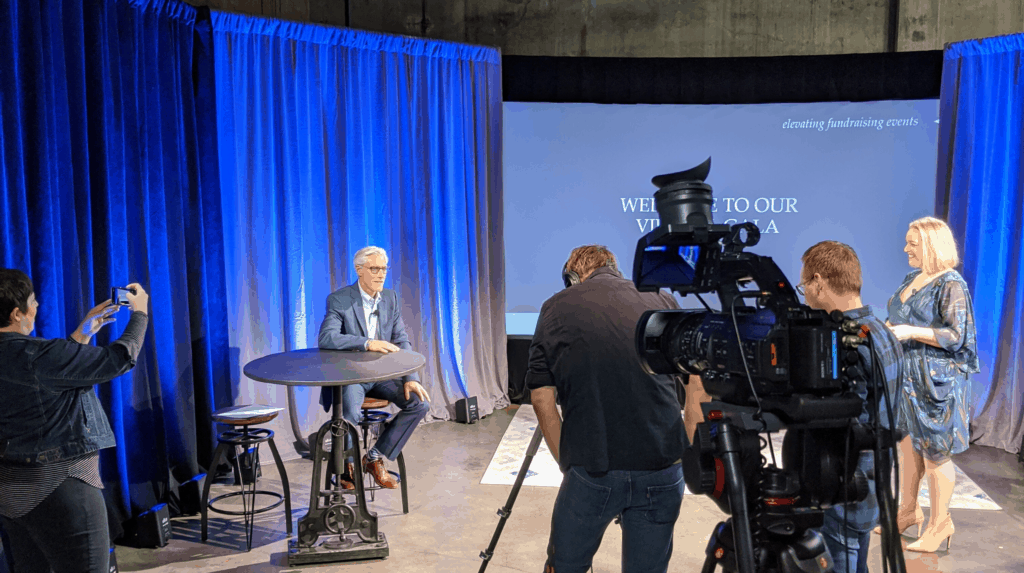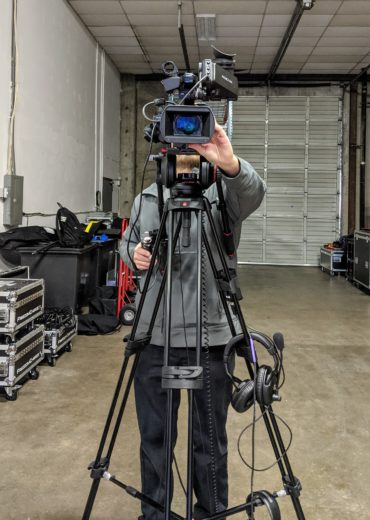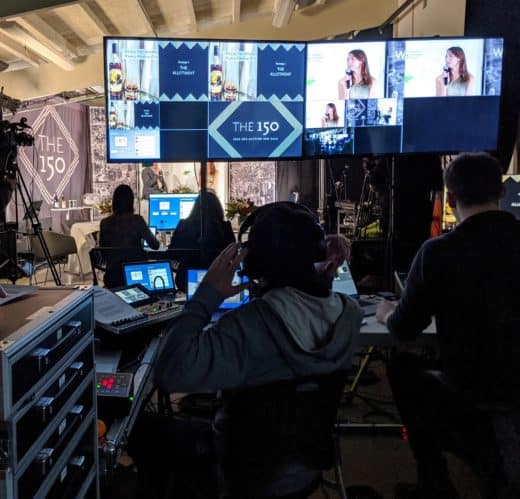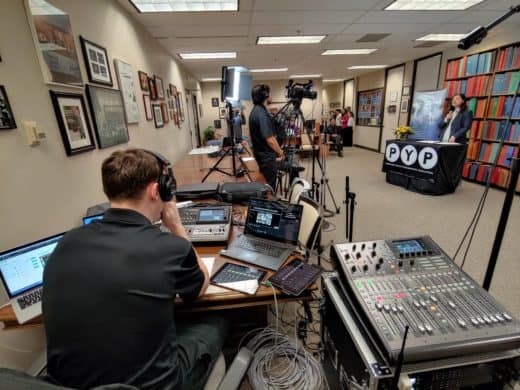
Part of our Virtual Fundraising Event and Gala series, view more articles here – Virtual Fundraising Events
We connect with Brian Harris and Todd Campbell from The AV Department to discuss the technical side of hosting virtual fundraising events.
A full-service live event audiovisual and media production company, The AV Department understands the needs of fundraising events and have been pioneers in creative live streaming events.
Here’s a condensed transcript of our conversation, including many tips along the way for a small, medium, or large scale live stream with or without the need for those hosting the event to be in the same location. Answers have been edited for clarity. (Greater Giving receives no benefit for suggesting any of the recommendations below—please perform your own review to determine appropriate fit for your organization.)
Live Streaming Services & Platforms
Let’s start off by discussing the streaming platforms you use most frequently.
We can use the client’s preferred platform and then push the video stream from our system to Vimeo, Youtube Live or Facebook Live. We primarily use Vimeo because it offers more customization than the other two platforms.
Why do you prefer Vimeo over other options?
It has the most flexibility. We can embed Vimeo anywhere our client wants. Either on their primary webpage or any other site. They also have great support and ease of use.
That sounds great, but how much does it currently cost?
Depends. For the live stream solution from Vimeo it can be quite affordable. Other proprietary solutions can be free, but with time/quality limitations.
We’ve also heard that there are organizations using tools like Zoom or GoToWebinar to host a virtual fundraising event. What’s the difference between those tools and the streaming platforms?
There’s a difference between teleconferencing and broadcasting a live event. Teleconferencing allows for real-time collaboration and interactions. Most people are familiar with Facetime which is a teleconferencing mobile-to-mobile situation. Some other solutions that are teleconferencing you may be familiar with are Zoom, GoToWebinar, or Google Duo. They are going to give you as close to a “live” environment from a standpoint of the time from the speaker talking to what the audience is seeing. It’s simple to register and access from a guest perspective but sometimes may require downloading an app or plug in. One downside to a teleconferencing solution is that you are limited to their platform and it’s capabilities. You can try to run a video but frequently it shows up very choppy for viewers and the audio isn’t as strong. You’re also potentially limited to the number of viewers and a restricted time limit for your stream depending on the type of account you have with the particular teleconferencing solution.
A broadcast, much like the local TV station, uses very specific and coupled equipment and services to show as many video, computer or other images and text you’d like to use. There are many technical components for a broadcast which causes what’s called latency — or a delay — between what is happening on camera and what the viewer sees. With a broadcast, data is transcoded, decoded, and encoded from the live in-person camera out to the video streaming platform. Although there is a 10-20 second delay between the in-person and what’s seen by the viewers, there are still possibilities for the host or emcee to engage with attendees and view and react to bids and donations in real-time. With broadcasting you have full control over the stream, it’s quality, an unlimited number of viewers, and the video sources you are showing to your audience.
What causes the latency or lag time with broadcasting compared to teleconferencing?
Turning a live image into digital and then transmitting over the internet takes some time, especially when you are using high quality broadcast cameras and video assets like promotional and appeal videos. In order to achieve real-time communication, teleconferencing software like Zoom and Facetime reduce the quality/bitrate and use specialized proprietary hardware. These applications are great resources but are not often suitable platforms where quality of audio/video is desired. While there may be a small amount of latency with a studio live stream, the difference is made up with excellent production value and lots of flexibility.
What engagement features are included with each platform?
Vimeo: Customizable depending on the type of account you have, but you can host a live chatbox, and show viewer count.
YouTube Live: Live chat, viewer count
Facebook Live: Live chat, viewer count, and audience engagement (like, love, haha, sad)
Teleconferencing solutions like Zoom, GoToWebinar, or Google Duo all have their own feature sets but usually include chat, Q&A, a webcam plug-in, and attendee count.
Any other important notes on any of the specific platforms?
In order to stream to YouTube on your mobile device, your selected channel has to have more than 1000 subscribers, so that is one limitation for its use. Many people are surprised to learn that to view a Facebook Live you don’t have to have a facebook page as long as the live stream is on a public page.
We primarily use Vimeo because of its ability to be customized and placed as a stream using an iFrame code on your organization’s website or other web page of your choice.
Wow! So much quality information. Now let’s change our conversation to talk about the equipment needed to host a live stream.
What is the least amount of technology needed to host a virtual event?
Of course that depends on the type of stream you are hosting, if it’s teleconferencing or a broadcast. But the most basic setup would need a computer, tablet or mobile phone, and the internet, a webcam, and a microphone.
What items would be needed for a mid-range setup?
If you wanted to up the quality of a teleconferencing live stream you could consider a higher quality microphone or webcam. For someone who is more tech savvy, you could look at the use of a software called Open Broadcaster Software (OBS) which is a free and open-source cross-platform streaming and recording program. It would function as a switcher between multiple feeds like a webcam, video content, and slides and then take that content and push the stream out to your desired location like Facebook Live or YouTube Live. OBS has a big learning curve if you’re a novice, but it can be picked up.
I think it’s important to note that one other way to improve the quality of a live stream is to have quality content that’s scripted, planned ways to engage your audience, and also to prepare anyone taking the virtual stage to look straight at the camera! It’s much different than being on stage at a live event.
How about what’s included in The AV Department’s setup?
On a recent live stream broadcast we did before our state’s stay-at-home order, we had the following:
● Two High Definition Cameras
● Video Switchers-creating a matrix where our technician/audience/host can see anything at any moment in 1080P.
● Audio tools-inputs like any variety of microphones which feed into an audio mixing console. One important note, anything you want viewers to hear during the stream needs to have a microphone-unlike at an in-person event.
With our broadcast we’re taking multiple sources (live camera, slides, pre-recorded video, etc) passing them through an encoder which then pushes the feed out to the desired streaming platform.
Under the current stay at home order, offices here in Oregon can still staff as long as they stay a minimum of 6 feet away from each other. With this setup we now have 1-2 people in our studio managing several streams on laptops with content from any number of feeds coming to us and then being pushed out as a single stream. You could easily engage an auctioneer on Zoom or Skype, have your Executive Director also join through a platform like that and we could integrate video and slide content from our location in the studio. We take all the different streams and splice them together then push out to the streaming platform. Usually we’re seeing a 20-second delay between live and what the viewers see.
Obviously the level of production you’re doing requires a different number of people both on-screen and behind the scenes. Let’s dive into the people side of the equation.
How many team members are needed to create a successful high-quality stream?
In Oregon we are currently under a stay at home order from the governor. Prior to that we hosted a few live streamed events and those productions had 7-10 people on-site from our team. That doesn’t count the auctioneer, emcee, talent, or individuals from the organization. With our in-studio set up we have lighting, backdrops, preview monitors and prompters for presenters. During the stream we had team members running cameras, a “director” managing what is being shown, a switchboard operator who manages all the feeds coming in cutting from live camera to slides and pre-recorded video, and our audio technician who balances audio levels for all the different feeds ensuring a video isn’t too loud or a microphone too soft. We have it set up so our audio tech is actually outside the main studio room so they are able to mix everything more appropriately.
Since the stay at home order we’ve got everything set up so we can facilitate a streamed event with as few people in the studio as possible and many key participants like the auctioneer, emcee, or nonprofit staff or board can join from remote locations.
How about a mid-range stream?
When we go out “on the road” and do a stream at someone’s office or other location we have between 3 and 5 team members. We would generally have two cameras, an audio technician, and one person who manages the switcher to mix the feeds together.
What about the least amount of people?
Honestly, you could go as small as one person being on video and followers watching on a teleconferencing platform.
Any other recommendations or best practices?
There are lots of options out there. Sit down with your committee or board and discuss your goals both financially and from a branding standpoint before making a decision. Our level of production isn’t what everyone needs, but we’d encourage you to investigate what options are out there that might fit your organization.
Once you’ve hosted your virtual event, you have a recording of the live stream which can be posted to your choice of video platforms and live on as great marketing content into the future. However one word of caution on your stream, be mindful of any music, videos or other audio you are using. Unless you own a license for the material or it’s happening live, we’d suggest not using it. You can easily purchase licenses for music from a variety of sites like Musicbed.com or Soundstripe.com which you would then own in perpetuity.
What should someone do if they are interested in learning more about The AV Department?
Visit our website, we’d be happy to talk with you about options for your organization. And even though we’re based in Oregon, we are able to capture and manage streams from any number of remote locations, so we can work with anyone nationally.
For more information about the AV Department and their support of Virtual events, please visit us at AVDepartment/VirtualEvents.

We are what’s referred to as an “emerging children’s museum” by the ACM. (Association of Children’s Museums) Before the pandemic we were just about to sign a lease and establish a location. We had been doing pop-up events, community festivals and school science fairs and such. Now as you know, live is different and we share our vision for children on-line, Facebook and Instagram, sharing tools and activities that challenge, inspire and instruct children in STEAM education.
Previously, we held an annual Wine Grab as our primary fundraising. This was a live event held in a rural venue where we served food, offered wine tasting and every attendee went home with a bottle of wine donated by local wineries in bags decorated by our area’s children.
This year we are hosting a Drive-by Wine Grab and want to combine it with an on-line auction. That’s where we need your help! We are hoping to make this simultaneously with our Drive-by event so viewers can experience the “parade” of cars picking up their wine, while also bidding on donated items. This will be outside with no WiFi so we are wondering if this is even possible to do using our data plans on our devices.
What are your thoughts? We heard you helped Holy Rosary School here in Woodland in their on-line auction so you’ve come highly recommended.
I also was on today’s Zoom from Impact Foundry with Eventology.
Thank you.
That definitely sounds like an interesting situation for these interesting times. I am going to share your information with one of our area representatives to give you a call and discuss how we can help. Thanks for reaching out!